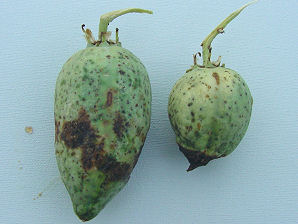Arizona Wild Flowers
Pictures, Photos, Images
Descriptions, Information, Reviews.
Joshua Tree, Yucca brevifolia.
We Are Proud Of Our SafeSurf Rating!
Click On Any Of The Following Links By Amazon.Com
For Books, & Videos About Wildflowers Of Arizona & The Southwest USA. No Obligation!
 |
| Joshua Tree |
|---|
 |  |
| Yucca brevifolia | Joshua Tree Flowers Lily Family ( Liliaceae ) |
|---|---|
 | |
| Joshua Tree Flower | Joshua Tree Seed Pods |
 |  |
| Joshua Tree Seed Pods 2" - 4" In length | Joshua Tree Seed Pods |
 /
/

Joshua Tree.
We wish to thank Wikipedia, the free encyclopedia for some of the information on this page. We share images and information with Wikipedia. Yucca brevifolia is the largest of the nine species of yucca in Arizona. It got its name from Mormon Pioneers, who thought it looked like Joshua praying. It is the symbol of the Mojave Desert. It can live about 100 to 300 years. Its flowering is governed by rainfall and temperature. It needs periods of low temperature to become dormant so that it can stay healthy. Many birds, rodents, insects, and reptiles make it their home. There are two varities of the Joshua Tree and they are classified as J. brevifolia var. herbertii and J. brevifolia var. jaegeriana. First classified as members of the Agave (Century Plant) Family, the Joshua Tree and other yuccas have been reclassified as members of the Lily (Liliaceae) Family. Joshua trees (as well as other yuccas) rely on the female Pronuba Moth for pollination. No other pollinator can transfer the pollen from one flower to another. The female Yucca Moth has evolved special organs which collect and distribute the pollen onto the surface of the flower. The moth then lays her eggs in the flowers' ovaries, and when the larvae hatch, they feed upon the yucca seeds. Without this moth, the Joshua Tree could not reproduce, nor could the moth, whose larvae need the seeds to eat. An old Joshua Trees can sprout new plants from its roots, however only the seeds produced by pollinated flowers can scatter far enough away from the old plant to establish a new stand of plants.
Yucca brevifolia is endemic to the Southwestern United States with populations in western Arizona, southeastern California, southern Nevada, and southwestern Utah. This range mostly coincides with the geographical reach of the Mojave Desert. The Joshua Tree is considered one of the major indicator species for the Mojave Desert. It is found at altitudes between 1,300 and 5,900 feet.
Quick Notes:
Height: Up To 30' Tall.
Trunk: Up To About 3 Feet Thick.
Flowers: Green-White, Waxy, Bell Shaped, Up To 2 1/2" Long, Tight Clusters On Stalks About 1 To 1/12 Foot Long At The Ends Of Branches. The Flowers Do Not Open Fully
And They are Followed By Egg Shaped Fruit.
Flowering Time: March - April.
Trunk: Up To About 1 1/2 Foot Thick. A single trunk with arm-like branches and old dry leaves left in place.
Leaves: Up To 14" In Length, Dark Green, Long And Narrow, Dense Clusters At The Ends Of Its Branches.
Found: Native to the southwestern United States; (AZ, CA, NV, UT). In Arizona, it is found at the edge of the Sonoran Desert and the Mojave Desert. About 20 Miles NW Of Wickenburg On US 93 On The Joshua Tree Parkway.
Hardiness:
Soil pH requirements:
Sun Exposure:
Elevation: 1,300 - 5,900 Feet.
Habitat: Hillsides, slopes, mesas, rocky plains with dry soils. Very often found growing in large groves
Miscellaneous: Flowering Photos Taken March 16, 2005. Seed Photos Taken June 6, 2003. Disected Pods Taken May 17, 2005 From Private Property in Phoenix. Great plant for xeriscape.
|



We Are Proud Of Our SafeSurf Rating!
Click On Any Of The Following Links By Amazon.Com
For Books, & Videos About Xerioscape Plants Of Arizona & The Southwest USA. No Obligation!
Click On Any Of The Following Links By Amazon.Com
For Books, & Videos About Wildlife Of Arizona & The Southwest USA. No Obligation!
Back To Arizona Wild Flowers Home Page.
Back To Arizona Wild Flowers, Cream - White Flowers Page Two.
Back To Arizona Wild Flowers; Other Colored Flowers Page Two.
Back To DeLange Home Page
© 1966 - Present, Audrey, Eve, & George DeLange
For Books, & Videos About Wildlife Of Arizona & The Southwest USA. No Obligation!
| © 1966 - Present, Audrey, Eve, & George DeLange |


